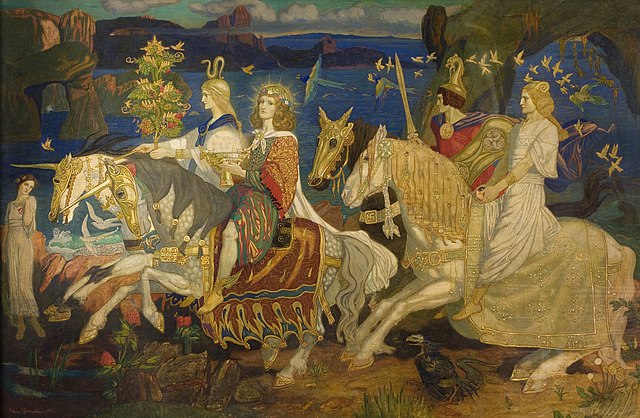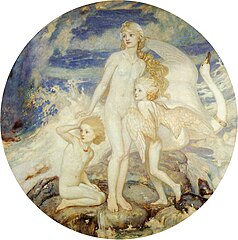Bodb Dearg: Chieftain of the Tuatha Dé Danann
Irish mythology is filled with tales of magic, transformation, and larger-than-life figures who continue to fascinate us. One such figure is Bodb Dearg, a king of the Tuatha Dé Danann, whose influence spans numerous stories and legends. This blog post will explore Bodb Dearg, why he’s an essential character in Irish mythology, and how his legacy lives today.
Table of Contents
Irish Mythology at a Glance
Ireland’s ancient stories are packed with supernatural deeds and bold characters. The Tuatha Dé Danann, a divine race of gods and heroes, stand at the heart of many of these tales. Among them is Bodb Dearg, a key leader chosen to rule after the Tuatha Dé Danann retreated to the sídhe (fairy mounds). This blog post will take you through his ancestry, key roles in famous Irish sagas, and the symbolism behind his name.
Who are the Tuatha Dé Danann?

The Tuatha Dé Danann are often described as a mighty and magical race that once ruled Ireland. After their defeat by the Milesians, they withdrew into the earth, inhabiting sídhe or fairy mounds. These places became gateways to the Otherworld—a realm of eternal youth and enchantment.
Bodb Dearg’s Ancestry
Bodb Dearg is said to be a son of the Dagda, one of the Tuatha Dé Danann’s most powerful chieftains. Known for his magical harp and cauldron of plenty, the Dagda was a generous and protective deity. Bodb Dearg inherited his father’s leadership qualities, eventually becoming a king among his people.
Meaning of the name “Bodb Dearg”
- Bodb (pronounced roughly “buv” or “bov”) is linked to the word for crow.
- Dearg translates to red.
Hence, Bodb Dearg can be interpreted as “Red Crow,” a name rich with symbolic meaning. Birds, especially crows, were significant in Celtic myth, often associated with war, prophecy, or transformation. The colour red, meanwhile, traditionally symbolises power, passion, and sometimes danger.
Pronunciation Notes
You may see variations such as Bodb Derg or Bodhbh Dearg. The name can be challenging to pin down in modern Irish precisely because of historical spelling and changing linguistic practices. However, remember that the sense of “red crow” holds constant.
The Chosen King of the Tuatha Dé Danann
After the Tuatha Dé Danann left the surface world, Bodb Dearg was chosen to lead them in the Otherworld. Some legends suggest that his father, the Dagda, named him as his successor. He established his dwelling in Munster, sometimes identified with Síd Femen, near modern Slievenamon in County Tipperary.
A Wise and Benevolent Ruler
Bodb Dearg is often depicted as a fair and wise king. He mediates disagreements and makes decisions with the well-being of his people in mind. While many deities of the Tuatha Dé Danann are known for their cunning or battle prowess, Bodb Dearg stands out for his kindly nature and diplomatic ability.
Appearance in Irish Mythology
The Children of Lir

One of Ireland’s most famous stories, The Children of Lir, revolves around the four children of a lord named Lir, who are turned into swans by their jealous stepmother. Bodb Dearg plays a significant role in this tale, watching over and caring for the children once they are transformed. His compassion and sense of responsibility towards these swan-children highlight his protective qualities.
The Wooing of Étaín (Tochmarc Étaíne)
In The Wooing of Étaín, we see the complex love story involving Midir and Étaín. Bodb Dearg’s presence in this narrative may not be as dramatic as others. However, he still appears as part of the royal gathering of the Tuatha Dé Danann, further underscoring his status and importance in their society.
Other References
Bodb Dearg occasionally appears in other tales, such as The Pursuit of Diarmuid and Gráinne, where many members of the Tuatha Dé Danann make brief appearances or are mentioned in passing. While these references may be brief, they reinforce his standing as a key figure woven into the fabric of Irish storytelling.
Bodb Dearg as “Red Crow”
Birds, especially crows and ravens, hold special significance in Irish and Celtic mythology. They are often connected with the Morrígan, fate, or the battlefield. Bodb Dearg’s crow aspect can suggest foresight and a tie to the realm of prophecy or supernatural power. The red colouring suggests authority, vitality, and possibly a hint of danger.
Kingship and Leadership
Bodb Dearg exemplifies many qualities admired in a Celtic king: justice, wisdom, and a strong duty to his people. The Otherworld associations—where time flows differently, and magic is abundant—reinforce his status as a guardian figure, bridging the mortal world with the realm of the gods.
Bodb vs. Badb (the War-Goddess)
A point of confusion for many enthusiasts is the name Bodb (or Badb), associated with a war goddess who forms part of the Morrígan. While the names are similar (and sometimes conflated in manuscripts), Bodb Dearg is generally treated as a separate deity, known for his kingship and benevolence rather than war and chaos.
The Importance of Contextual Reading
Medieval Irish scribes did not always distinguish clearly between similar names, and different manuscripts may blend or separate the figures. When reading these stories, it’s worth paying close attention to the context and consistent references to leadership, family ties, and domains to differentiate Bodb Dearg from the war goddess.
Influence on Modern Irish Culture
Although not as widely recognised as other legendary figures such as Cú Chulainn or the Morrígan, Bodb Dearg remains a vital part of Ireland’s mythic tapestry. His presence can be felt in local folklore and stories told in rural areas, especially around sites linked to him in Munster.
Literature, Pop Culture, and Revivals
Fantasy and historical fiction writers sometimes draw inspiration from Bodb Dearg’s story, infusing their works with elements of Irish mythology. Meanwhile, scholars continue to uncover and discuss layers of meaning in the old texts, ensuring that Bodb Dearg’s legacy thrives.
Conclusion
Bodb Dearg stands out in Irish mythology as a wise and compassionate king, bridging the mortal realm and the sídhe world. As the son of the Dagda, he exemplifies the responsibility and generosity that Celtic myths often celebrate in their leaders. His story offers timeless themes of family, transformation, and duty—reminding us of ancient tales’ enduring power and relevance.
Whether you’re new to Irish mythology or a long-time fan, Bodb Dearg’s tales remind you of the rich depth of the Tuatha Dé Danann and their influence on Ireland’s cultural heritage. We hope this introduction inspires you to delve further into Celtic lore’s vibrant, enchanting world.
Additional Resources
- Reading List
- The Children of Lir
- The Wooing of Étaín (Tochmarc Étaíne)
- Medieval Irish manuscripts like the “Book of Leinster” and “Lebor Gabála Érenn” (The Book of Invasions)
- Online Databases
- CELT (Corpus of Electronic Texts) for original texts and translations
- Recommended Scholarly Works
- Lady Augusta Gregory’s Gods and Fighting Men
- T.W. Rolleston’s Celtic Myths and Legends
- Marie-Louise Sjoestedt’s Gods and Heroes of the Celts
Dive into these resources to discover more about Bodb Dearg and the enchanting world of the Tuatha Dé Danann. Let the magic of Irish mythology spark your imagination!
